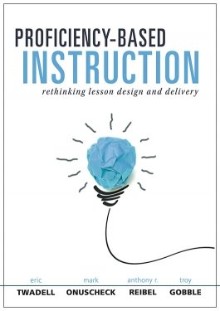Rethinking How We Design and Teach Lessons
Proficiency-Based Instruction: Rethinking Lesson Design and Delivery
By Eric Twadell, Mark Onuscheck, Anthony R. Reibel, and Troy Gobble
(Solution Tree Press, 2019 – Learn more)

For those of you who haven’t noticed (smile), society has changed drastically over the years. Politics, technology, and new knowledge have forever altered how we interact and how we learn.
Educational initiatives have come and gone, standards have been written and rewritten, and research has changed our understanding of teaching and learning. So why, then, do classrooms and lesson plans look remarkably the same?

In their book Proficiency-Based Instruction: Rethinking Lesson Design and Delivery, they break down the deeply flawed, longstanding traditional approach to lesson design and delivery, and walk readers through reimagining their planning and instruction to develop the proficiency of every learner.
The book begins with a truth that all educators with classroom experience undoubtedly know: “Teaching likes order. But, as it turns out, learning doesn’t.” In the introduction, the authors outline the assumptions about teaching and the realities of learning, examine the Madeline Hunter lesson planning template, and analyze six habits that have developed in teaching and learning.
Their in-depth analysis provides a resounding affirmation for the need for proficiency-based instruction, and the team-oriented structure of the book made me want to gather my colleagues together in the middle of my summer break to begin working toward proficiency-based instruction immediately!
Chapter 1: Implementing Proficiency-Based Instruction: Five Stages of the Creative Process
To set the foundation for the implementation of proficiency-based instruction, the authors use the work of psychologist Mihaly Csikszentmihalyi (1990). His five stages of the creative process provide the impetus for educators making the shift in their teaching practices and also the framework for the rest of the book.
Not only does this chapter break down the five stages, it also provides considerations for teams as they begin rethinking and redesigning their instruction and delivery. “By intentionally addressing these five stages in the change process, teachers and teams receive better professional development that leads to a different approach to instruction” (12). And you know what? I think they are on to something.
Chapter 2: Preparation
It is obvious in this chapter that the authors understand change. They spend an entire chapter focusing on the importance of developing a foundation for change that includes the why, the how, and the steps needed for success. In addition to providing key points to remember during this stage of a team’s implementation journey, they also introduce us to a team looking to move toward proficiency-based instruction, share two commitments of proficiency-based instruction, and define five components of proficiency-based instruction.
Chapter 3: Incubation
Recognizing that change requires time for questioning, thought, and critical analysis, the third chapter in the book encourages teams to engage in honest dialogue comparing and contrasting the advantages, obstacles, connections, and possibilities of proficiency-based instruction. Continuing with the team introduced in the second chapter, the authors provide an example of such dialogue and address four common questions about proficiency-based instruction.
Chapter 4: Insight
The fourth chapter focuses on the importance of discussing individual and collaborative insights that emerge from changing lesson design and delivery. The story of the teacher team continues in this chapter as they progress through this stage and discover an instructional diamond lesson plan that begins and ends with student performance.
Included in this chapter are amazing insights into lesson development, self-inquiry questions, the experiences teachers should be providing in their classrooms to reveal how students are attempting to learn rather than” if they learned,” and the creation of “desirably difficult” situations to further students’ learning. It is a jam-packed chapter with a plethora of thought-provoking insights.
Chapter 5: Evaluation
“In proficiency-based instruction, assessing students is one half of the puzzle; the other half of the puzzle requires that teachers and teams make ongoing, immediate instructional shifts to help support learning as it is happening” (77). To that end, this chapter focuses on the importance of evaluating change as it is happening.
The team’s story continues, and four competency activities of proficiency-based teaching are introduced where students perform, contemplate, observe, and reflect (84-85). This chapter also provides teachers with non-evaluative language questions to provide feedback as well as promote reflection and self-evaluation.
Chapter 6: Elaboration
The focus of the sixth chapter is how proficiency-based instruction requires teachers to be flexible and adaptive, basically in a state of constant inventiveness, as they question how well their ideas are working, notice data patterns and trends, and make adjustments for immediate improvement. The authors share seven elaborative instructional practices they typically see at this stage (106). Readers again can follow the team’s story to illustrate how a group of teachers might progress through the stage.
Chapter 7: Proficiency-Based Lessons in the Classroom
High on the list of every educator reading books about instructional practice are specific examples of how lessons really work in the classroom and templates that can be easily adapted for teacher use. Chapter seven provides both of those, including specific examples in both math and English.
Chapter 8: Discipline-Specific Examples of Proficiency Based Instruction
This chapter takes a more in-depth look at lesson plans in both math and social studies, walking readers through the steps of creating proficiency-based lessons and culminating with a reproducible Proficiency-Based Instruction Planning Tool.
Final Thoughts
Written with collaborative teams in mind, this book makes the shift from traditional instruction to proficiency-based instruction a lot less daunting. I could easily see using this in our curriculum teams to explore proficiency-based instruction since its structure lends itself so well to PLC groups (and I am actually going to pitch that idea to my curriculum director later this week!).
Using the story of a team made up of different types of educators helped illustrate what the process might actually look like in a real school setting, and the story also made the process more relatable. As a teacher using standards-based grading in my classroom, I found myself saying “YES!” numerous times and feel like this book really can provide a foundation for change in our district.
The authors’ intent was to offer a map for others migrating toward proficiency-based instruction to follow. I think they accomplished that and more in this easy-to-read book that makes me want to jump right in and get started with my peers.
Jennifer Savery currently serves as a middle school teacher, technology integrationist, new teacher mentor, curriculum leader, and Authentic Intellectual Work anchor in the Humboldt Community School District in Humboldt, Iowa. In her 25-year career, she has taught both high school and middle school English and Spanish, worked with both high school and middle school at-risk students in success centers, facilitated graduate programs in Educational Leadership and Development at Southwest Minnesota State University, earned her principal licensure at the Iowa Principal Leadership Academy, and enjoyed teaching in both Wisconsin and Iowa. Jennifer is passionate about assessment and utilizing technology for learning.



































